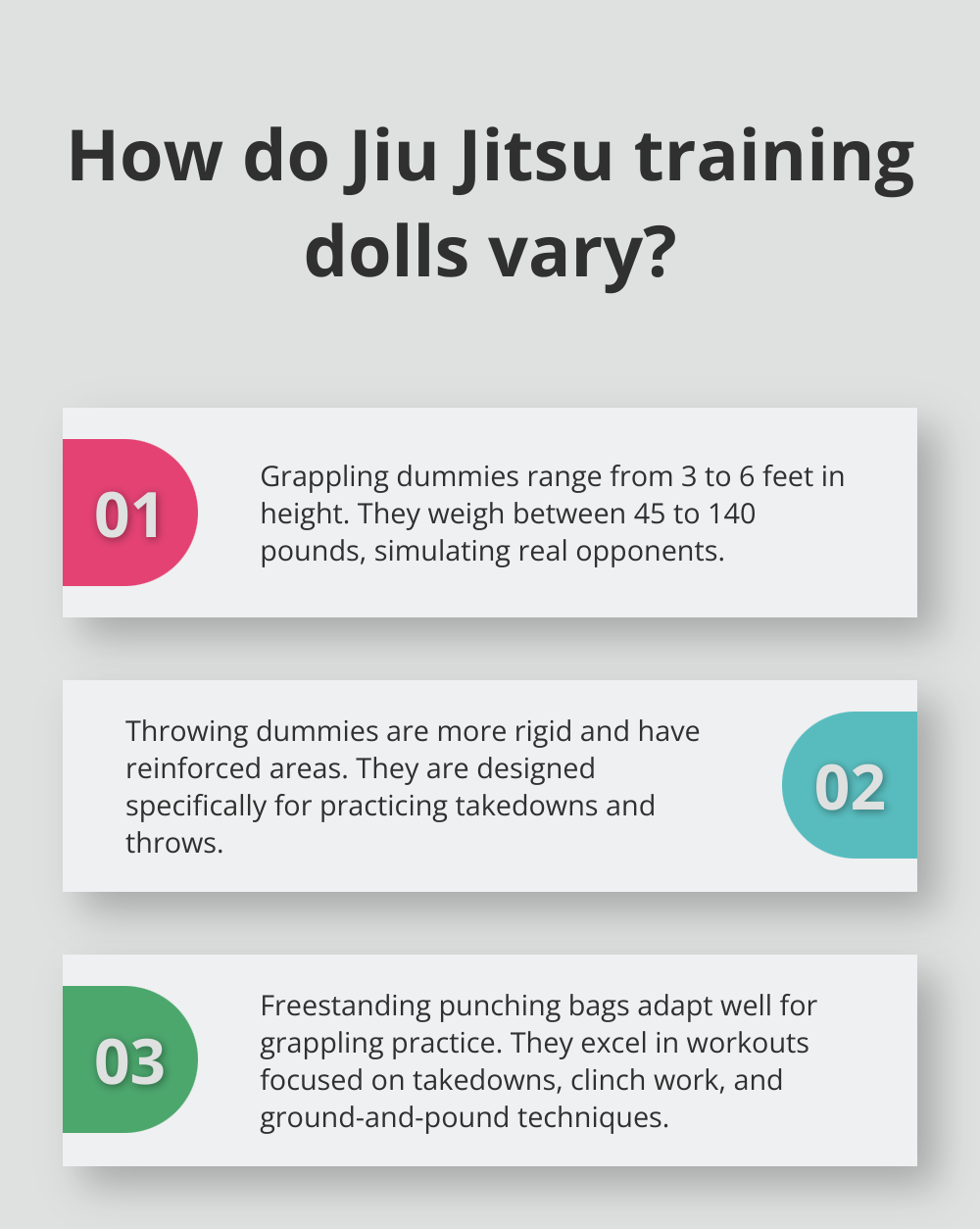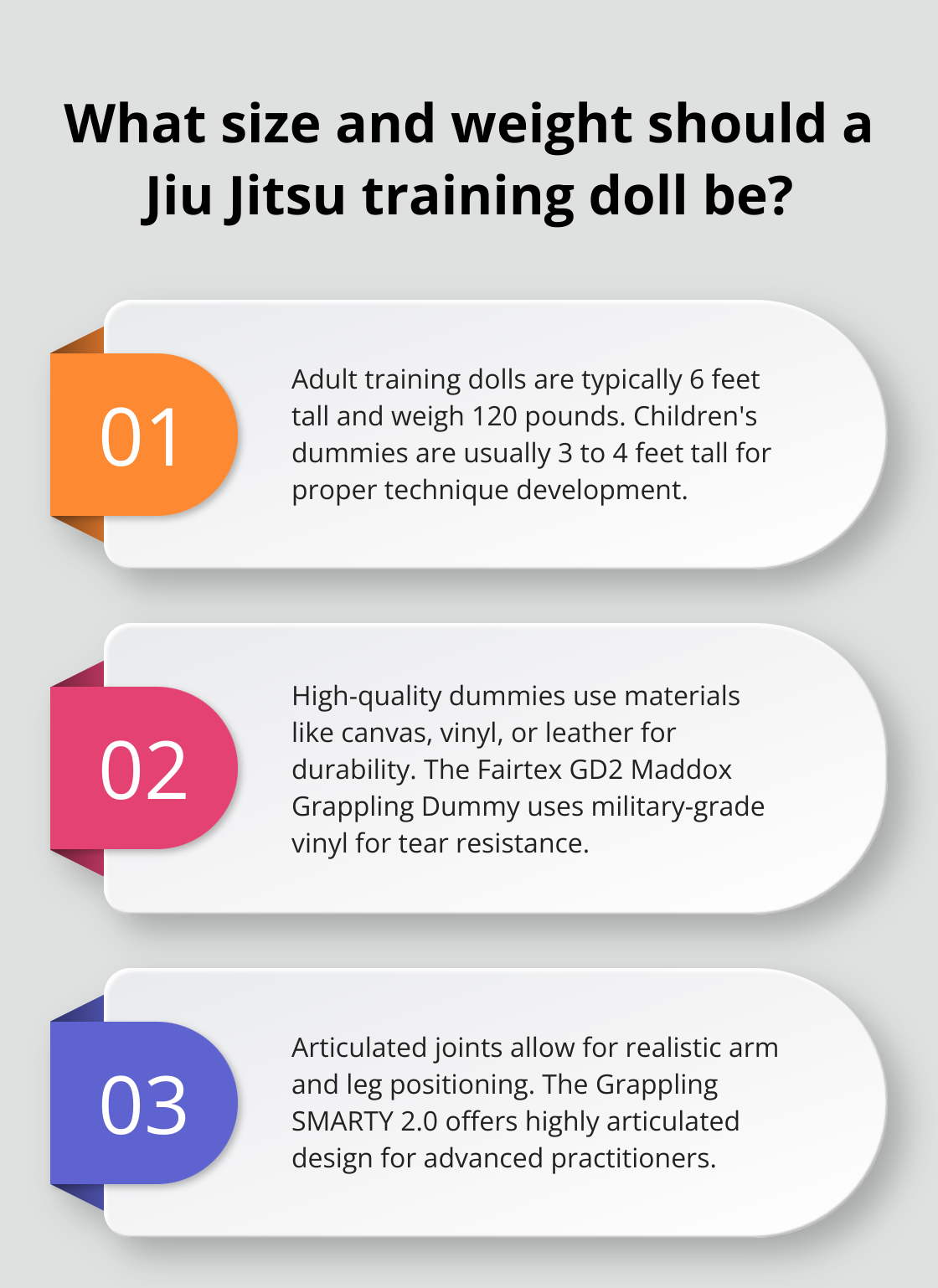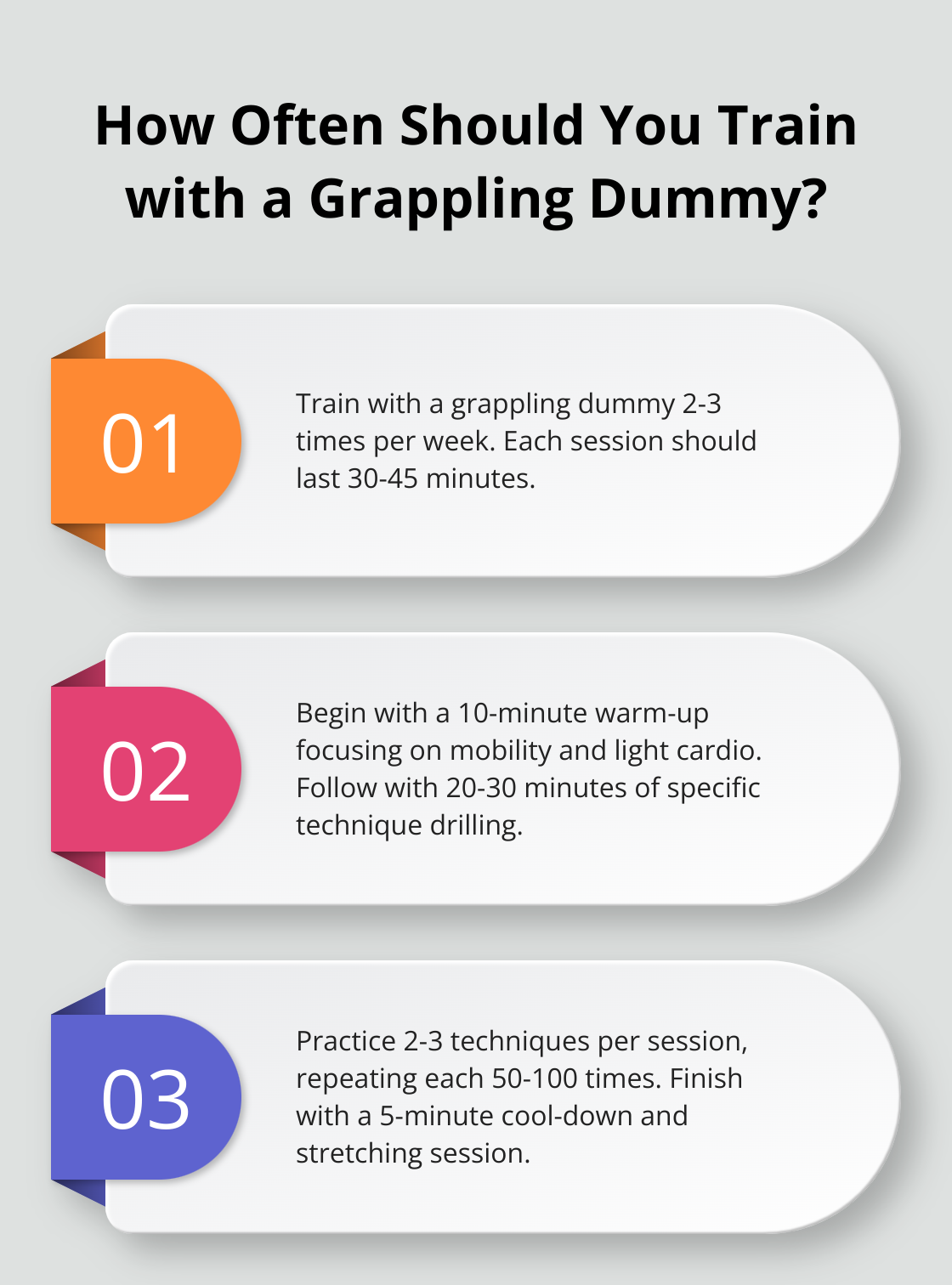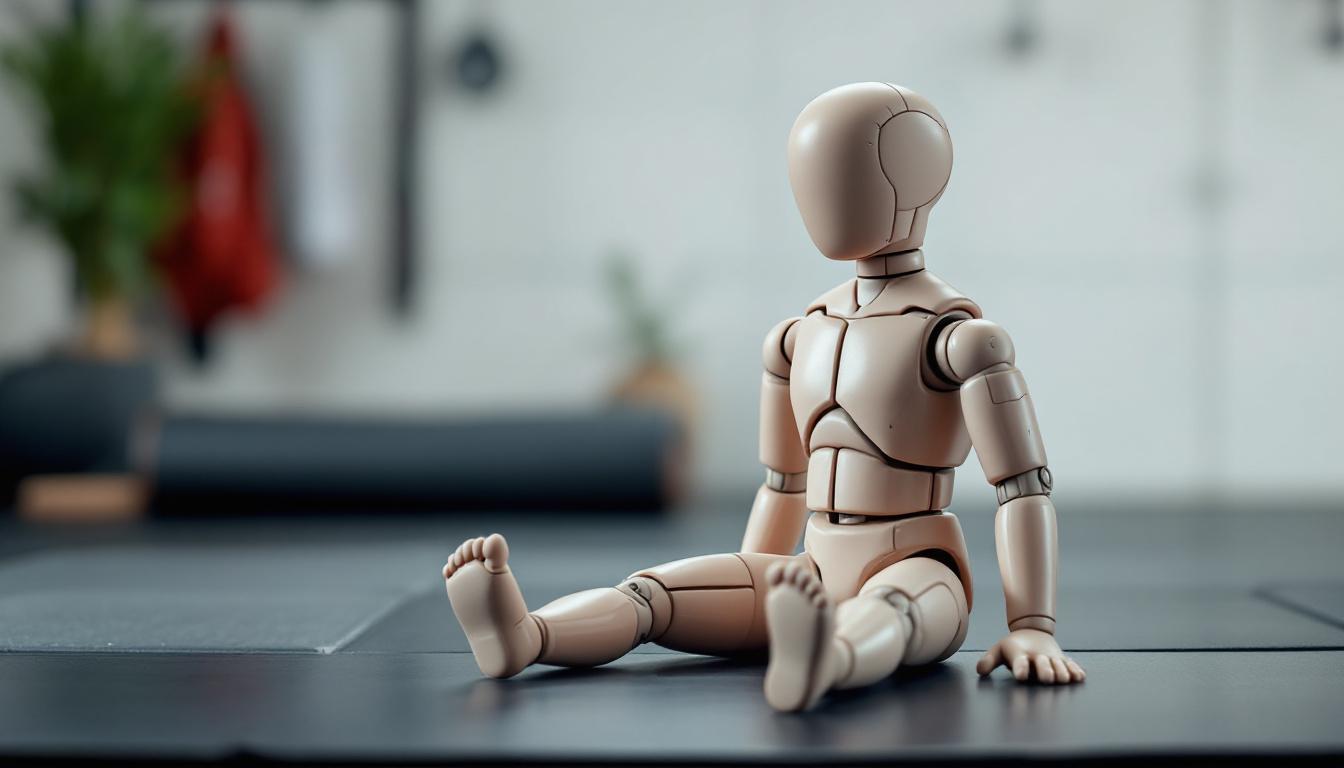At Jiu Jitsu, we understand the importance of consistent training to improve your skills. A Jiu Jitsu training doll can be an invaluable tool for practitioners looking to refine their techniques outside of regular classes.
These versatile training aids come in various forms, each designed to help you perfect specific aspects of your grappling game. In this post, we’ll guide you through the process of selecting the ideal training doll to elevate your Jiu Jitsu practice.
Types of Jiu Jitsu Training Dolls
Jiu Jitsu training dolls offer various forms, each designed to enhance specific aspects of your grappling skills. Understanding these different types will help you select the most effective tool for your training needs.
Grappling Dummies
Grappling dummies represent the most common type of training doll used in Jiu Jitsu. These human-shaped dolls typically range from 3 to 6 feet in height and weigh between 45 to 140 pounds. They simulate a real opponent, allowing practitioners to drill techniques like armbars, chokes, and leg locks. The Fairtex GD2 Maddox Grappling Dummy stands out as a popular choice among Jiu Jitsu players due to its durability and realistic feel.
Throwing Dummies
Throwing dummies cater specifically to practicing takedowns and throws. They often exhibit more rigidity than grappling dummies and feature reinforced areas to withstand repeated impacts. The Suples throwing dummy exemplifies this category, offering multiple grip points for various throwing techniques. These dummies prove particularly useful for Judo practitioners or those focusing on the standing aspects of Jiu Jitsu.
Freestanding Punching Bags
While not traditional Jiu Jitsu equipment, freestanding punching bags adapt well for grappling practice. They excel in workouts focused on takedowns, clinch work, and ground-and-pound techniques. The Century BOB (Body Opponent Bag) stands out as a popular choice, providing a human-like torso and head for more realistic training.
Specialized BJJ Dolls
Some manufacturers have developed dolls specifically for Brazilian Jiu Jitsu training. These dolls often feature more articulated joints and realistic positioning. The Grappling SMARTY 2.0 has a very well developed system. These specialized dolls (while often carrying a higher price tag) offer unparalleled training specificity.

When selecting a training doll, consider your specific needs and training goals. A beginner might benefit from a basic grappling dummy, while an advanced practitioner might invest in a specialized BJJ doll for more nuanced technique work. While these dolls serve as excellent training aids, they should complement (not replace) live partner training at a reputable academy.
Now that we’ve explored the various types of training dolls available, let’s examine the key features you should consider when making your selection.
Key Features to Consider in a Jiu Jitsu Training Doll
When you select a Jiu Jitsu training doll, several key features can significantly impact your training experience. Let’s explore the most important aspects to consider.
Size and Weight
The size and weight of your training doll should closely match your own body type or that of your typical opponents. For adults, a 6-foot doll weighing around 120 pounds often provides the most realistic training experience. However, if you’re smaller or working on specific techniques, a lighter 70-pound dummy might be more manageable. Children and teens should opt for smaller dummies (typically around 3 to 4 feet tall) to ensure proper technique development.
Material and Durability
High-quality materials like canvas, vinyl, or leather ensure your dummy withstands rigorous training sessions. The Fairtex GD2 Maddox Grappling Dummy, for instance, uses military-grade vinyl that resists tearing and punctures. This durability translates to a longer lifespan and better value for your investment. Cheaper dummies made from less resilient materials might save money initially but often need replacement within months (costing more in the long run).
Flexibility and Joint Articulation
The degree of flexibility in your training doll can dramatically affect the techniques you can practice. Dummies with articulated joints allow for more realistic arm and leg positioning, which is essential for perfecting submissions like armbars or triangle chokes. The Grappling SMARTY 2.0, with its highly articulated design, enables practitioners to drill effectively. This level of articulation particularly benefits advanced practitioners focusing on intricate techniques.
Filling Material
Filling material plays a role in flexibility. Sand-filled dummies offer a more rigid feel, ideal for takedown practice, while foam-filled options provide greater pliability for ground techniques. Some high-end models allow users to adjust the filling, providing versatility for different training focuses.
Grip Points and Handles
Grip points and handles are often overlooked but can significantly enhance your training. Multiple grip points allow for practicing various grips and holds, while strategically placed handles can assist in positioning the dummy for different drills. The Suples throwing dummy, for example, features multiple grip points specifically designed for throwing techniques.

As you weigh these features, prioritize those that align with your specific training goals and skill level. A beginner might benefit more from a basic, durable model, while an advanced practitioner could justify investing in a highly articulated, specialized BJJ doll. Now that we’ve covered the key features to consider, let’s explore how to effectively incorporate these training dolls into your practice routine.
How to Maximize Your Training Doll’s Potential
Setting Up Your Training Space
Create a dedicated training area before you start. Lay down proper mats to cushion falls and protect your joints. Clear at least 10×10 feet of space to move freely. Position your doll in the center of this area, securing it if it’s a freestanding model. For grappling dummies, use a wall or sturdy furniture to prop them up initially. Some popular brands like Fairtex, Grappling Smart, and Century make great dummies with various features, including human-like characteristics and heavier models for takedown practice.
Structuring Your Solo Sessions
Add doll training to your routine 2-3 times a week, for 30-45 minute sessions. Begin with a 10-minute warm-up focusing on mobility and light cardio. Then, spend 20-30 minutes drilling specific techniques. Finish with a 5-minute cool-down and stretching session.

Plan your sessions in advance. Focus on 2-3 techniques per session, performing each 50-100 times. This repetition builds muscle memory and refines your movements. Use a timer to maintain a steady pace and track your progress.
Technique Refinement and Safety
Apply submissions slowly and with control when practicing. This prevents wear on the doll and allows you to focus on proper form. For throws and takedowns, clear your space of obstacles and use controlled force to protect yourself from injury.
Pay close attention to your body positioning. Use a mirror or record yourself to check your form. Common mistakes include improper hip alignment in guard passes or incorrect hand placement in chokes (addressing these issues early prevents bad habits from forming).
Complementing Live Training
Training dolls are valuable, but they can’t replace live training. Use doll sessions to reinforce techniques learned in class. Before your next live roll, spend 15 minutes drilling the moves you’ve practiced on the doll. This bridges the gap between solo and partner work, improving your execution in real scenarios.
Personalizing Your Training
Discuss your doll training with instructors. This allows for personalized guidance and ensures your solo work aligns with class curriculum. The goal is to supplement, not replace, your regular training at the academy.
Consistent, focused practice with your doll (combined with regular attendance at classes) will accelerate your progress and deepen your understanding of techniques. Transform your training doll from a simple prop into a powerful ally in your grappling journey.
Final Thoughts
Jiu Jitsu training dolls provide a powerful way to enhance grappling skills outside regular classes. These tools allow practitioners to refine techniques, build muscle memory, and improve overall performance. A consistent training partner enables you to drill specific moves repeatedly, which accelerates your progress and deepens your understanding of Jiu Jitsu principles.

The right training doll selection proves essential for maximizing practice sessions. You must consider factors such as size, weight, material, flexibility, and specialized features that align with your training goals. A Jiu Jitsu training doll (designed to meet your specific needs) can become an invaluable asset in your grappling journey.
We at Souza Grappling Co. offer a range of classes and programs to help you reach your full potential. Our facility provides opportunities to improve technique, build strength, and join a supportive community of fellow practitioners. Visit us today to discover how our instructors can complement your training doll practice and accelerate your progress on the mats.




